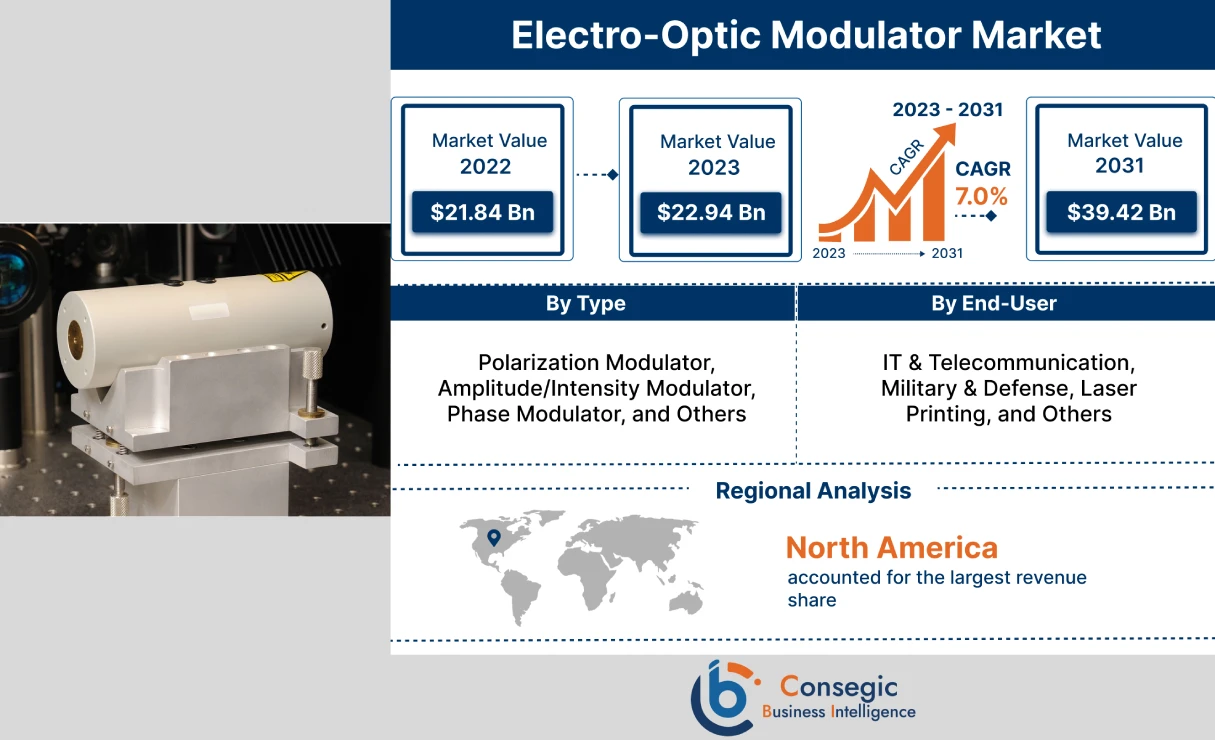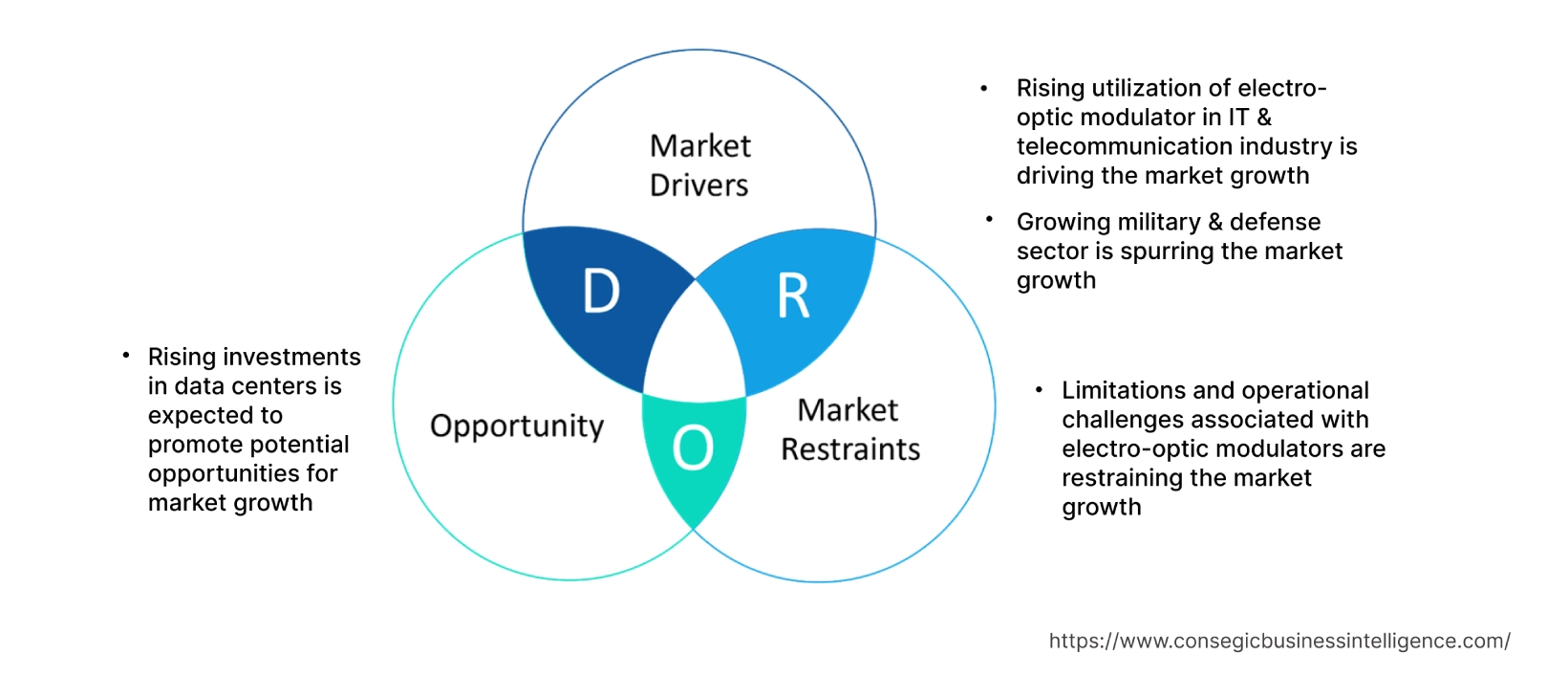- Summary
- Table Of Content
- Methodology
Electro-Optic Modulator Market Size :
Electro-Optic Modulator Market size is estimated to reach over USD 39.42 Billion by 2031 from a value of USD 21.84 Billion in 2022 and is projected to grow by USD 22.94 Billion in 2023, growing at a CAGR of 7.0% from 2023 to 2031.
Electro-Optic Modulator Market Scope & Overview:
Electro-optic modulators refer to optical devices that utilize a signal-controlled element displaying an electro-optic effect for modulating a beam of light. Modulation is often imposed on the amplitude, frequency, polarization, or phase of the beam. Moreover, electro-optic modulators offer several benefits including low dielectric constant, high optical quality and transmission, low dielectric loss tangent, and elimination of distortions in modulators output from piezoelectric resonances. The aforementioned benefits of electro-optic modulator are key determinants for increasing its utilization in IT & telecommunication, military & defense, laser printing, and other sectors.
Electro-Optic Modulator Market Insights :
Key Drivers :
Rising utilization of electro-optic modulator in IT & telecommunication industry is driving the market growth
Electro-optic modulators are primarily used in the IT & telecommunication sector for various applications including base stations, broadcast stations, and fiber-optic communication systems among others. Electro-optic modulators are used to convey information onto an optical frequency carrier in telecommunication systems. Moreover, electro-optic modulators are capable of transferring signals over vast distances with minimal loss. Electro-optic modulators alter the phase of a carrier signal to ensure that the transmitted data is appropriate for reception and decoding at the destination end. Additionally, the integration of electro-optic modulators in telecommunication systems also facilitates high-speed data transmission and enables efficient transmission of large amounts of information. The above benefits of electro-optic modulators are primary determinants for increasing their adoption in the IT & telecommunication industry.
Factors including the growing deployments of 5G infrastructure, rising adoption of smartphones and advanced communication devices, and increasing demand for wireless communication are major prospects driving the growth of the IT & telecommunication industry.
For instance, according to the Department of Telecommunication of India, the total deployment of 5G base stations across India reached 324,192 as of August 2023, depicting a substantial growth of over 100% from 53,590 base stations in January 2023.
Thus, the growth of telecommunication industry is fostering the utilization of electro-optic modulators for its application in telecom base stations and fiber-optic communication systems for providing high-speed data transmission, in turn driving the growth of the market.
Growing military & defense sector is spurring the market growth
Electro-optic modulators are used in the military & defense sector for applications involving military vehicles, defense aircraft, and radar among others. Electro-optic modulators offer high speed and optical efficiency without the requirement for beam-forming optics. Moreover, electro-optic modulators are primarily utilized for imaging and data recording applications in the military & defense sector. The utilization of electro-optic modulators in military & defense platforms enables high-speed recording of analog imagery or digital data on photographic film. Additionally, electro-optic modulators are also deployed in military radar systems for modulating the radar signals for multiple purposes, including target tracking, detection, and navigation.
Factors including the increasing investments in military & defense equipment and vehicles along with rising production of air defense systems are primary determinants for driving the growth of the military & defense sector.
For instance, in December 2022, Dassault Aviation, a France-based manufacturer of military aircraft and business jets, launched its new Rafale fighter aircraft for deployment in the Directorate General of Armaments, a French military procurement agency. Furthermore, in December 2022, the Department of Defence of the United States invested approximately USD 50 million for the automation of future army ground vehicles as a part of the Army's Robotic Combat Vehicle program. The investment aims at facilitating military vehicles designed for reconnaissance, surveillance, and high-risk missions.
Hence, the increasing investments in the military & defense sector and rising production of military aircraft are driving the adoption of electro-optic modulators for imaging, data recording, optical communications, and radar applications. The above factors are further proliferating the growth of the market.
Key Restraints :
Limitations and operational challenges associated with electro-optic modulators are restraining the market growth
The utilization of electro-optic modulators is usually associated with few limitations and operational challenges, which is a key factor limiting the market growth.
For instance, electro-optic modulators are usually associated with complexities and difficulties in designing and circuitry, particularly in receiver set. Moreover, electro-optic modulators have low noise immunity, which leads to unclear reception in case of weak signals caused by noise generation.
Additionally, the vulnerability of electro-optic modulators to noise generation also results in deterioration of quality of the original signal at the receiving end, in turn affecting the quality of signals. Therefore, the aforementioned limitations and operational challenges associated with electro-optic modulators are constraining the growth of the market.
Future Opportunities :
Rising investments in data centers is expected to promote potential opportunities for market growth
The rising investments in data centers is expected to present potential opportunities for the growth of the electro-optic modulator market. Modern data centers increasingly depend on interconnects for providing critical communications connectivity among numerous servers, memory, and computation resources. Electro-optic modulators are often used in fiber optic systems in data centers for transmitting data at high speeds over long distances. Moreover, the features of electro-optic modulators including high bandwidth, low power consumption, high-speed data transmission, and the ability to transmit large amounts of data are key aspects increasing its utilization in data centers.
Factors including the growing pace of digitalization, increasing deployment of cloud services, and rising investments in development of data centers are expected to facilitate lucrative growth aspects for the market.
For instance, in October 2022, IONOS Group SE, in collaboration with Fasthosts, launched a new data center with an initial investment of approximately USD 24.4 million in Worcester Six Business Park located in the United Kingdom. Additionally, in November 2021, Tencent Cloud launched its new data center in Brazil in order to fulfill the rising demand for digitalization in Latin America. The launch of the new data center provides highly reliable and stable cloud services to facilitate the growth of Brazilian and other Latin America-based businesses.
Hence, the rising investments in development of data centers are projected to drive the adoption of electro-optic modulators in data centers for high-speed data transmission, in turn stimulating opportunities for market growth during the forecast period.
Electro-Optic Modulator Market Report Insights :
| Report Attributes | Report Details |
| Study Timeline | 2017-2031 |
| Market Size in 2031 | USD 39.42 Billion |
| CAGR (2023-2031) | 7.0% |
| By Type | Polarization Modulator, Amplitude/Intensity Modulator, Phase Modulator, and Others |
| By End-User | IT & Telecommunication, Military & Defense, Laser Printing, and Others |
| By Region | North America, Europe, Asia-Pacific, Latin America, and Middle East & Africa |
| Key Players | Thorlabs Inc., Coherent Corp., APE GmbH, Lightwave Logic Inc., Newport Corporation, Conoptics Inc., QUBIG GMBH, Versawave Technologies Inc., IXBlue, Hamamatsu Photonics K.K. |
Electro-Optic Modulator Market Segmental Analysis :
By Type :
Based on the type, the market is bifurcated into polarization modulator, amplitude/intensity modulator, phase modulator, and others. The polarization modulator segment accounted for the largest revenue share in the year 2022. Polarization modulator offers an additional degree of freedom in the modulation of the carrier waves in communication systems. Moreover, polarization modulators are suitable for RF signal processing involving frequency translation, filtering, and amplification of signals. Additionally, polarization modulators are primarily used in IT & telecommunication industry among others.
According to Viavi Solutions Inc., the overall number of cities globally with 5G deployments reached 1,947 as of January 2022, with the addition of 635 new 5G cities in 2021. Thus, the growing telecommunication sector is among the key factors driving the deployment of polarization modulators for utilization in telecom base stations and communication systems, in turn contributing to the growth of the market.
The phase modulator segment is anticipated to register the fastest CAGR growth during the forecast period. Phase modulators are capable of encoding a message signal as variations in the instantaneous phase of a carrier wave. Phase modulators are also used for conditioning communication signals for transmission. Moreover, the primary benefits of phase modulators include high modulation speed, lower signal power consumption, simple circuit design, and ease of modulation among others. Additionally, phase modulators are also capable of modulating the radar signals for various purposes, including target detection, tracking, and navigation. The above benefits of phase modulators make it ideal for utilization in military & defense, IT & telecommunication, and other industries.
For instance, Thorlabs Inc. and IXBlue are among few of the companies that offer electro-optic phase modulators for telecommunication and laser applications among others. Therefore, the rising development of phase modulators for utilization in telecommunication, military & defense, and other industries is among the vital factors expected to drive the growth of the market during the forecast period.
By End-User :
Based on the end-user, the market is segregated into IT & telecommunication, military & defense, laser printing, and others. The IT & telecommunication segment accounted for the largest revenue share of 41.5% in the year 2022. Factors including the increasing deployments of 5G infrastructure, rising penetration of advanced communication devices, and growing demand for wireless communication are driving the growth of the IT & telecommunication sector.
For instance, according to GSM Association, most of the European countries installed commercial 5G services in 2021, whereas two thirds of regional operators launched 5G networks. Additionally, according to GSM Association, 5G connections across Europe are estimated to reach 311 million by 2025.
Therefore, the growth of telecommunication sector is driving the adoption of electro-optic modulators for utilization in base stations and fiber optic communication systems, in turn proliferating the growth of the market.
Military & Defense segment is expected to witness fastest CAGR growth during the forecast period. The growth of military & defense segment is attributed to several factors including rising investments in military & defense vehicles along with increasing production of air and maritime defense systems among others.
For instance, in April 2022, Huntington Ingalls Industries introduced its new Block IV Virginia-class attack submarine that is primarily developed for the U.S. navy. The submarine is designed for performing several coastal and open-water missions. Hence, the rising development of military & defense systems is increasing the adoption of electro-optic modulators for imaging, data recording, optical communications, and military radar applications, in turn proliferating the market growth during the forecast period.
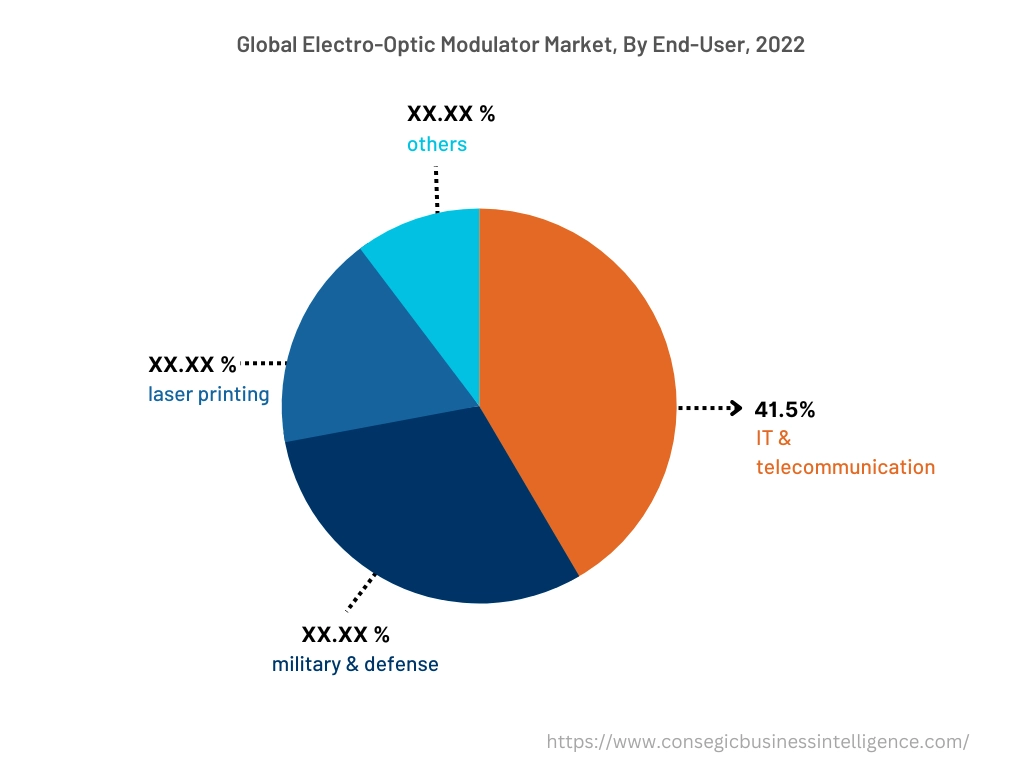
By Region :
The regional segment includes North America, Europe, Asia Pacific, Middle East and Africa, and Latin America.
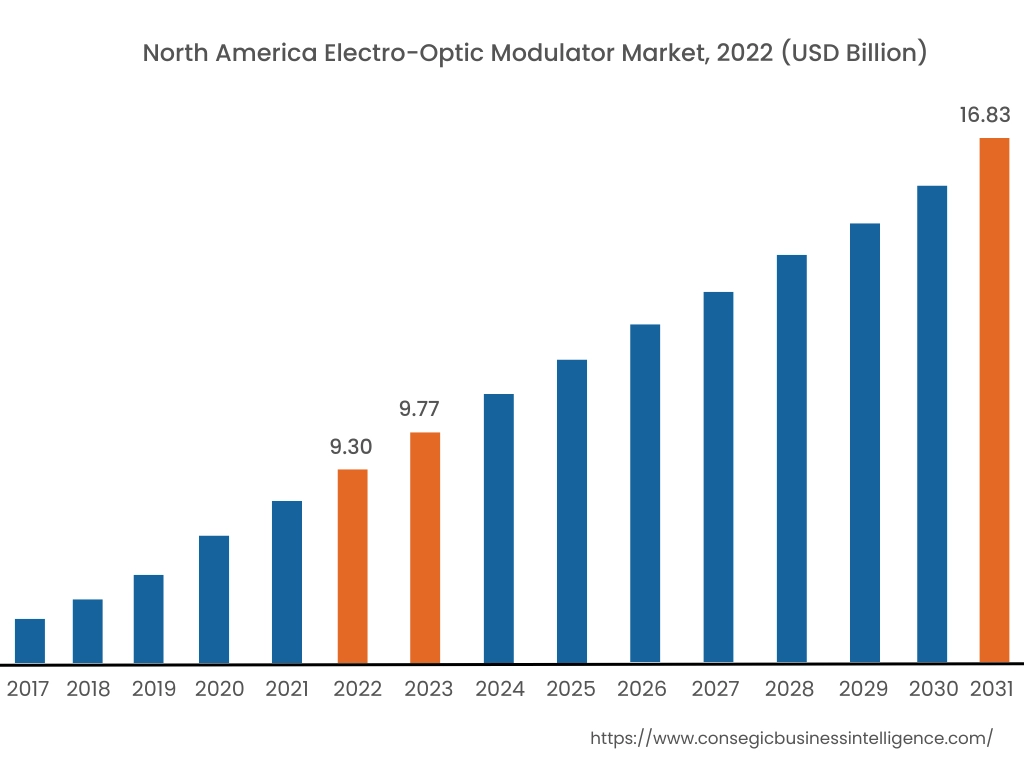
North America accounted for the largest revenue share of USD 9.30 Billion in 2022 and is expected to reach USD 16.83 Billion by 2031, registering a CAGR of 7.0% during the forecast period. Also, the market is projected to acquire revenue of USD 9.77 Billion in the year 2023. In addition, in the region, the U.S. accounted for the maximum revenue share of 58.5% in the same year. The adoption of electro-optic modulators in the North American region is primarily driven by its usage in military & defense, IT & telecommunication, and other industries. Additionally, the rising utilization of electro-optic modulators in telecommunication infrastructure including base station, broadcast stations, and fiber optic communication systems for providing high speed data transmission over long distances are among the significant factors driving the market growth in the region.
For instance, according to the GSM Association, the total 5G connection deployments across North America reached nearly 140 million as of 2022. Thus, the growing telecommunication industry is fostering the deployment of electro-optic modulators for high-speed communication and data transfer applications, in turn driving market growth in the North American region. Further, factors including the increasing investment in military & defense sector is anticipated to foster opportunities for market growth in North America during the forecast period.
Asia-Pacific is expected to register the fastest CAGR growth of 7.2% during the forecast period. The growing pace of industrialization and development is creating lucrative growth prospects for the market in the region. Additionally, factors including the growth of multiple industries such as military & defense, telecommunication, laser printing, and others are driving the market growth for electro-optic modulators in the Asia-Pacific region.
For instance, according to Invest India, the Government of India allocated USD 70.6 billion to the Ministry of Defense as the part of its Union Budget 2022-23. The primary focus of the budget allocation to the Indian Ministry of Defense is to help in the development of new unmanned vehicles and systems, military ground vehicles, and other related systems. Hence, rising investment in military & defense sector is anticipated to drive the utilization of electro-optic modulators for applications including military imaging, data recording, optical communications, and radar systems, thereby, driving market growth in the Asia-Pacific region during the forecast period.
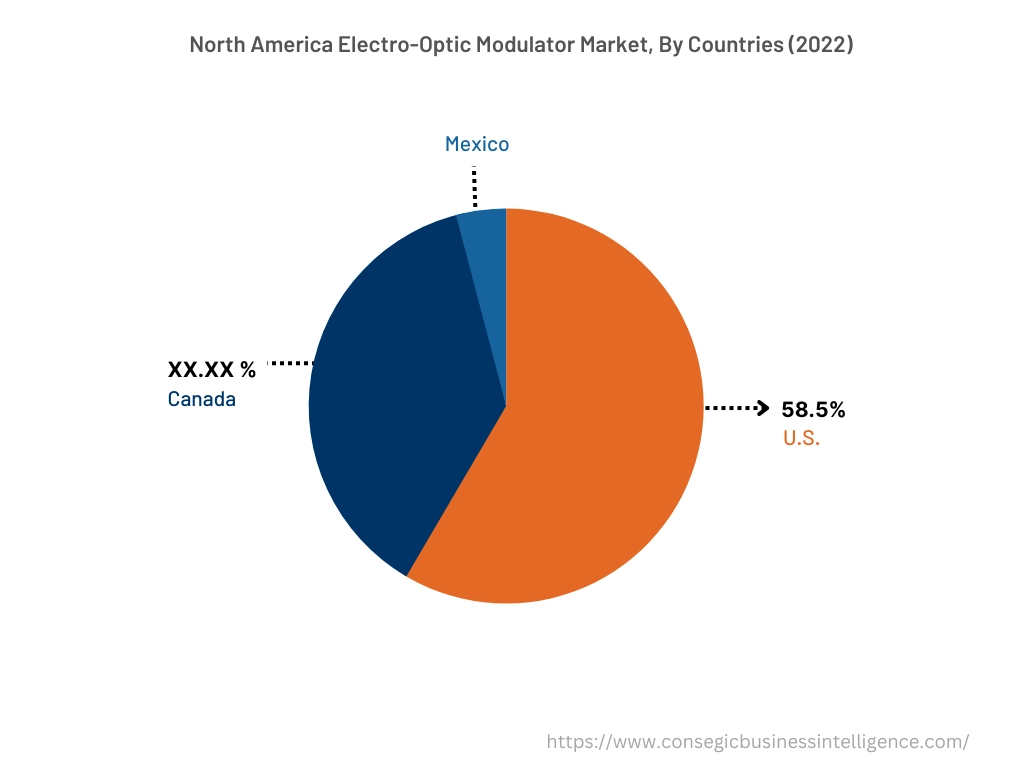
Top Key Players & Market Share Insights:
The electro-optic modulator market is highly competitive with major players providing electro-optic modulators to the national and international markets. Key players are adopting several strategies in research and development (R&D), product innovation, and end-user launches to hold a strong position in electro-optic modulator market. Key players in the electro-optic modulator market include-
- Thorlabs Inc.
- Coherent Corp.
- Versawave Technologies Inc.
- IXBlue
- Hamamatsu Photonics K.K.
- APE GmbH
- Lightwave Logic Inc.
- Newport Corporation
- Conoptics Inc.
- QUBIG GMBH
Recent Industry Developments :
- In 2022, IXBlue introduced a new generation of phase modulators that are designed for high-power fibre lasers. The phase modulators offer lower RF power consumption while maintaining stability under outdoor temperature variations.
Key Questions Answered in the Report
What is electro-optic modulator? +
Electro-optic modulators refer to optical devices that utilizes a signal-controlled element displaying an electro-optic effect for modulating a beam of light. The modulation is often imposed on the amplitude, frequency, polarization, or phase of the beam.
What specific segmentation details are covered in the electro-optic modulator report, and how is the dominating segment impacting the market growth? +
For instance, by type segment has witnessed polarization modulator as the dominating segment in the year 2022, owing to its increasing utilization in IT & telecommunication and other industries.
What specific segmentation details are covered in the electro-optic modulator market report, and how is the fastest segment anticipated to impact the market growth? +
For instance, by end-user segment has witnessed military & defence as the fastest-growing segment during the forecast period due to rising adoption of electro-optic modulator in military & defence sector for imaging, data recording, optical communications, and military radar applications.
Which region/country is anticipated to witness the highest CAGR during the forecast period, 2023-2031? +
Asia-Pacific is anticipated to register fastest CAGR growth during the forecast period due to rapid pace of industrialization and growth of multiple industries such as military & defence, telecommunication, laser printing, and others.
